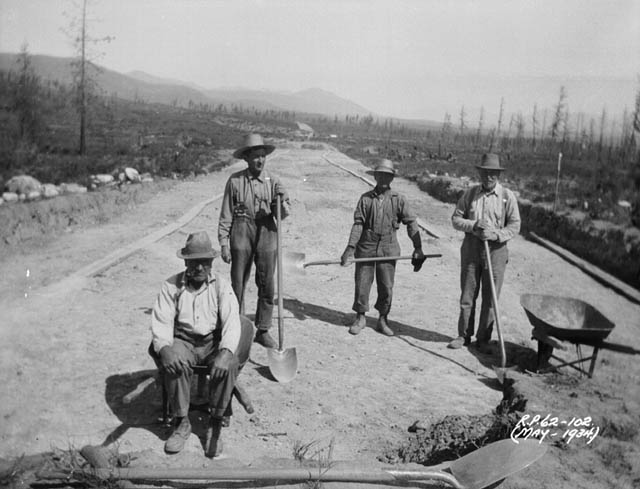Work Camps for the Unemployed
The extensive unemployment of the Great Depression meant there were thousands of single men out of work. The federal government was worried that large populations of unemployed single men in urban areas would lead to unrest. Furthermore, the government was concerned these men would become involved in Communism and Canada was interested in quashing any opportunity for a surge in Communist involvement. In 1932 the federal government decided to establish work camps that provided work for thousands of unemployed single men across the country.
The unemployment camps provided employment, shelter, medical care, and food. They men were also paid 20 cents per day for their labour. This daily wage, however, was inadequate compensation for the 44-hour work weeks that included hard manual labour, like clearing bush, planting trees, building roads, and constructing buildings. Employed men completing the same work would be paid ten times more. Technically it was a voluntary choice to go an unemployment relief camp, but often men who resisted were arrested for vagrancy. The Department of National Defence operated the camps like a military training camp.
(RELIEF PROJECTS - NO. 62). ROAD CONSTRUCTION AT KIMBERLY-WASA, BRITISH COLUMBIA MAY 1934. SOURCE: WIKIMEDIA COMMONS
The unrest the government tried to suppress by placing the men in the camps ironically flourished among the men in the camps. The men became unhappy with their living conditions and low wages. The government was criticized for simply moving the men and providing inadequate conditions, rather than addressing larger issues of unemployment and low wages. Discontent among the men resulted in protests and strikes, one of the largest being to the On-to-Ottawa Trek which originated in Vancouver. Check out our last blog post for more information on the On-to-Ottawa Trek!
The camps were closed in June 1936. Upon the closure of the relief camps 170,248 men had lived and worked in camps across the country.
The Second World War broke out in 1939, twenty-one years after fighting ceased in the First World War. WWI left belligerent countries broke and fatigued. The 1920s and 1930s presented their own ups and downs, including extreme global economic booms and busts. Though there were hints at the time, we can see through hindsight the lead up to the beginning of WWII throughout the 1930s. In this blog series, important local, national, and international economic and cultural events and attitudes are discussed as Canada and the world prepares to engage in another massive global conflict.


